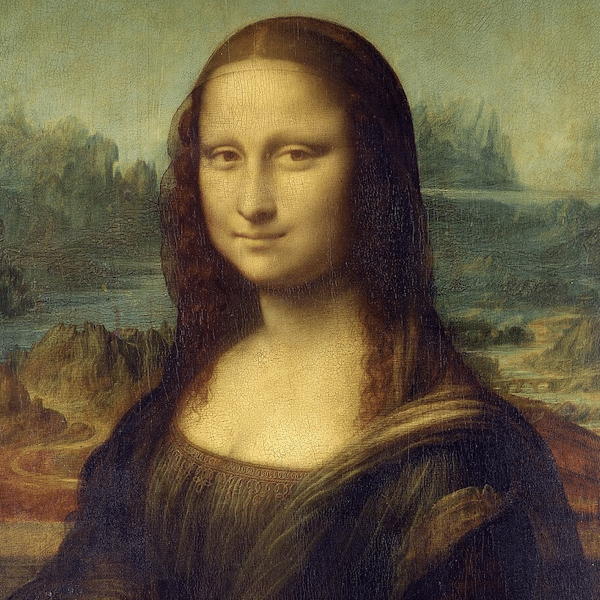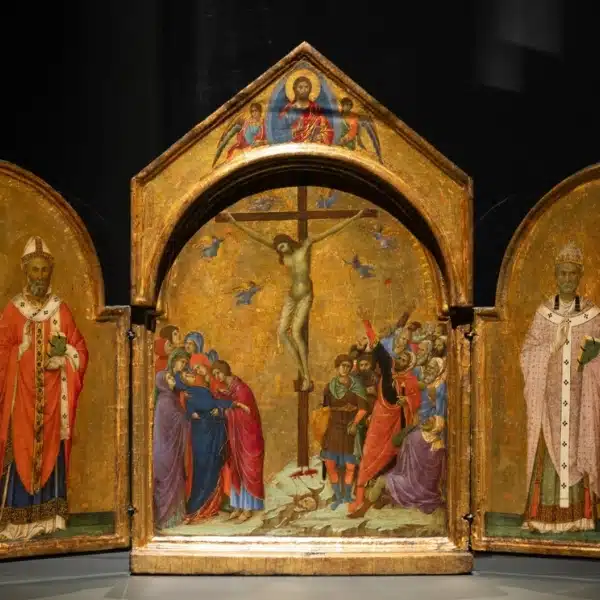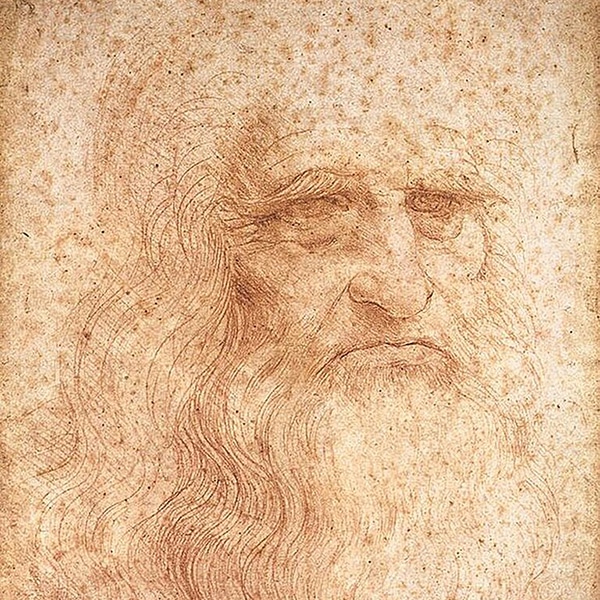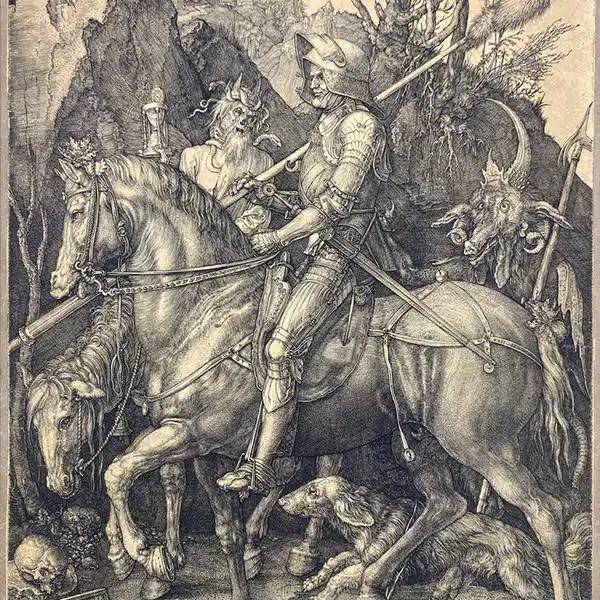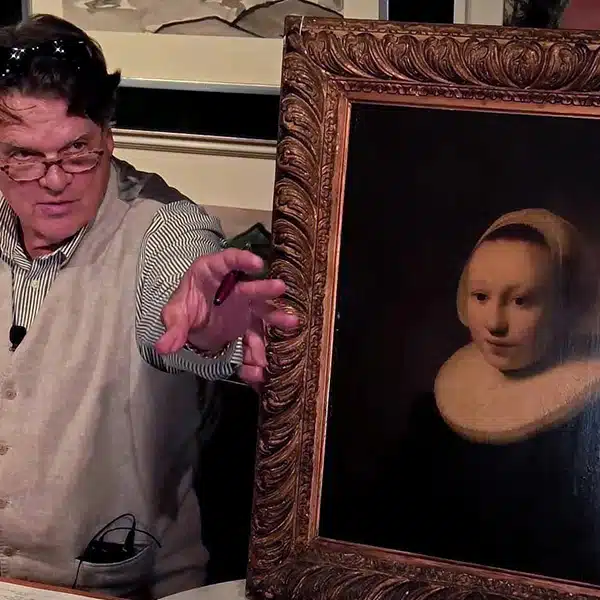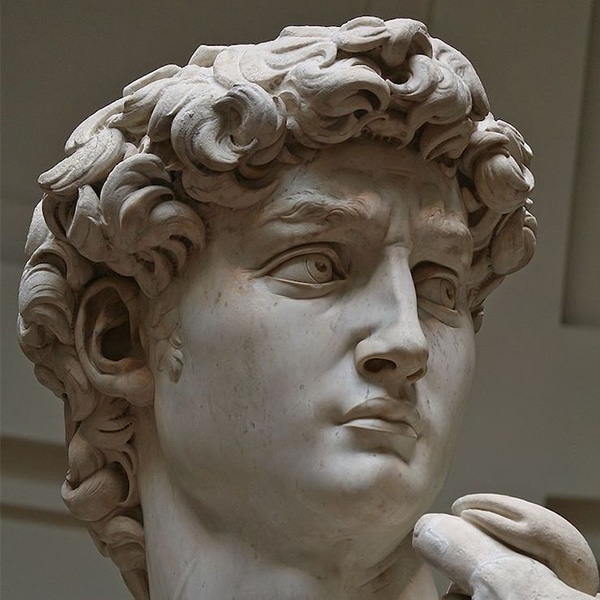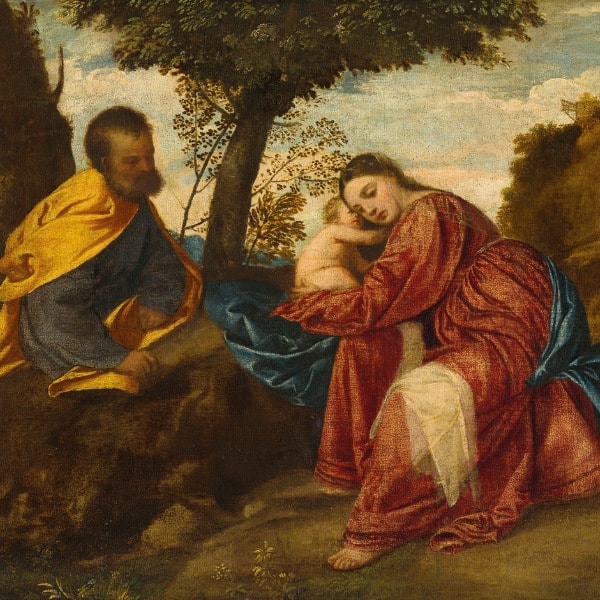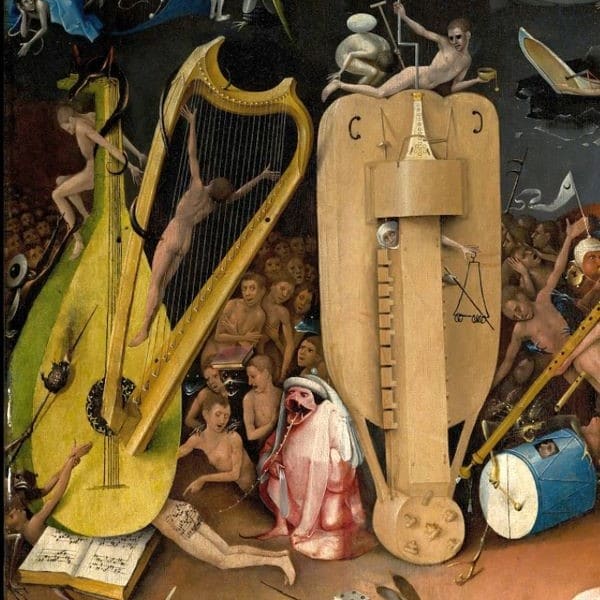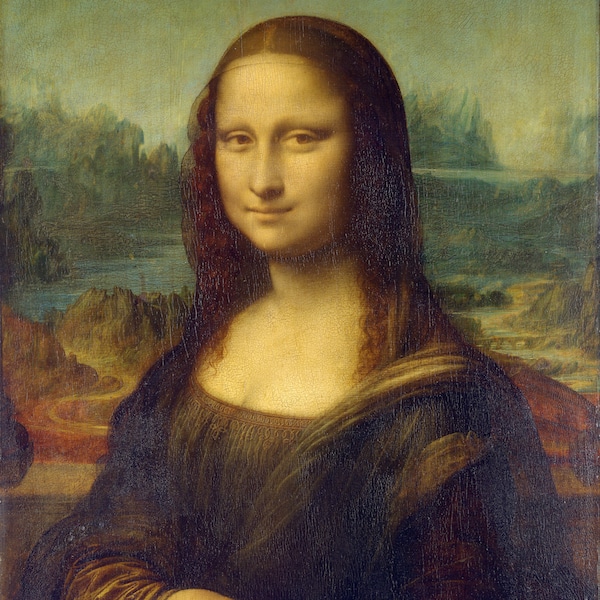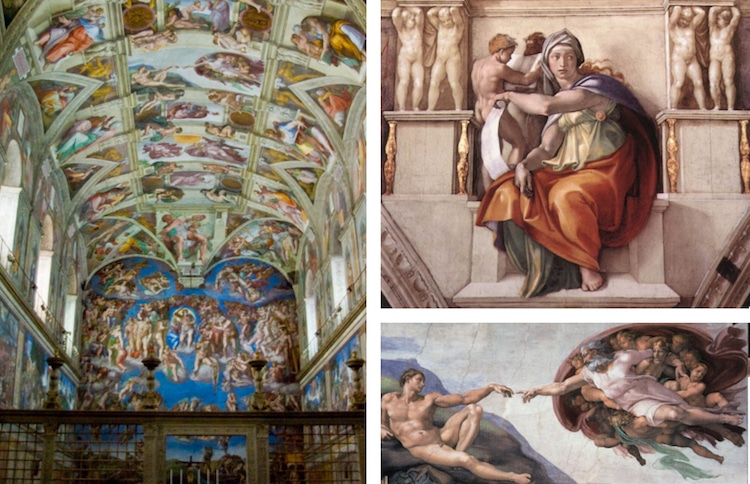
Italian artist Michelangelo (1475–1564) is known as one of the most prolific painters and sculptors in history. As a key figure of the High Renaissance, he is specifically celebrated for his ambitious approach to scale and his expertise in anatomy. While all of his masterworks convey his undeniable talent, his world-famous fresco on the ceiling of the Sistine Chapel stands above the rest.
Painted for the pope, the busy yet beautifully balanced composition depicts a range of religious iconography rendered in Michelangelo's distinctive style, making it one of the most cherished masterpieces in the world.
What is the Sistine Chapel?
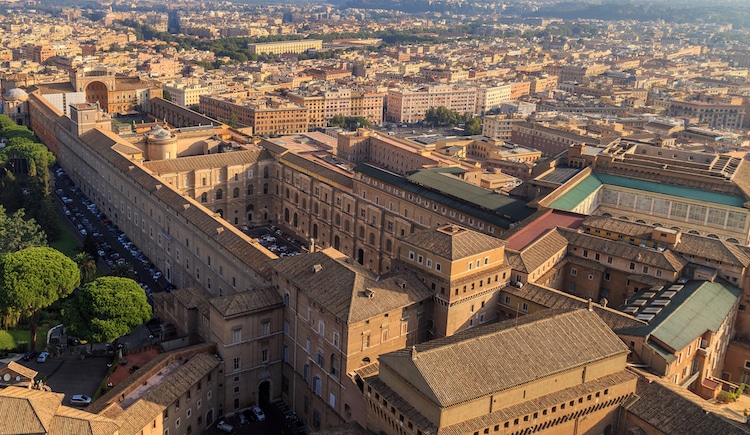
Aerial view of the Sistine Chapel and the Vatican Museums in Rome (Photo: Bova/Depositphotos)
The Sistine Chapel is a large chapel located in the Vatican's Apostolic Palace. It is named after Pope Sixtus IV, who oversaw its restoration in the late 15th century. Historically, the chapel has had various important functions. Today, it retains its religious role, as it serves as the site where cardinals meet to elect the next pope.
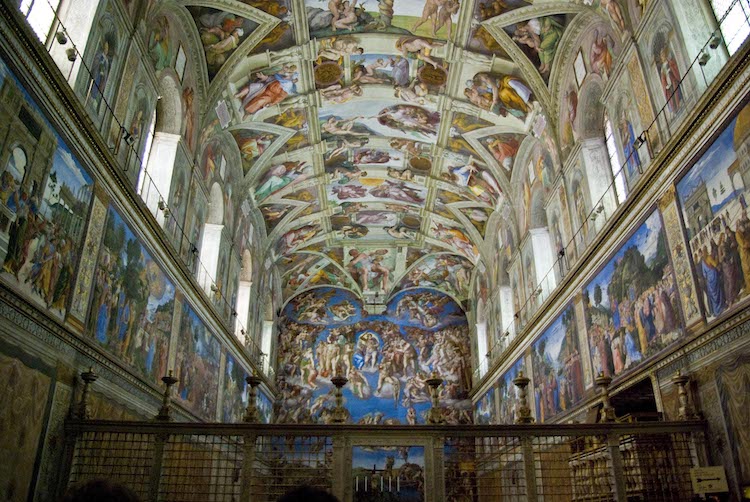
Interior of the Sistine Chapel (Photo: Antoine Taveneaux via Wikimedia Commons, CC BY-SA 3.0)
What the Sistine Chapel is most well-known for, however, is its ceiling. Painted by Florentine artist Michelangelo di Lodovico Buonarroti Simoni between 1508 and 1512, the complex and colorful fresco is celebrated for its realistic figures, vast size, and innovative process.
Commissioning the Sistine Chapel Ceiling

View of the Sistine Chapel ceiling (Photo: Jean-Christophe Benoist via Wikimedia Commons, CC BY-SA 3.0)
By the early 16th century, Michelangelo was an famous Renaissance artist that was highly regarded throughout Italy. He was particularly praised for his ability to render—both in painting and sculpture—figures with lifelike anatomical features, as evident in his famous David statue from 1504. Given the artist's reputation, it is no surprise that Pope Julius commissioned Michelangelo to decorate the ceiling of Sistine Chapel, whose walls were already adorned with frescoes by Botticelli, Ghirlandaio, Perugino, and other famed artists.
While the pope's plans for the ceiling revolved around a depiction of the 12 apostles, Michelangelo had bigger plans: he would paint several scenes from scripture featuring over 300 figures.
How Did Michelangelo Paint the Sistine Chapel?
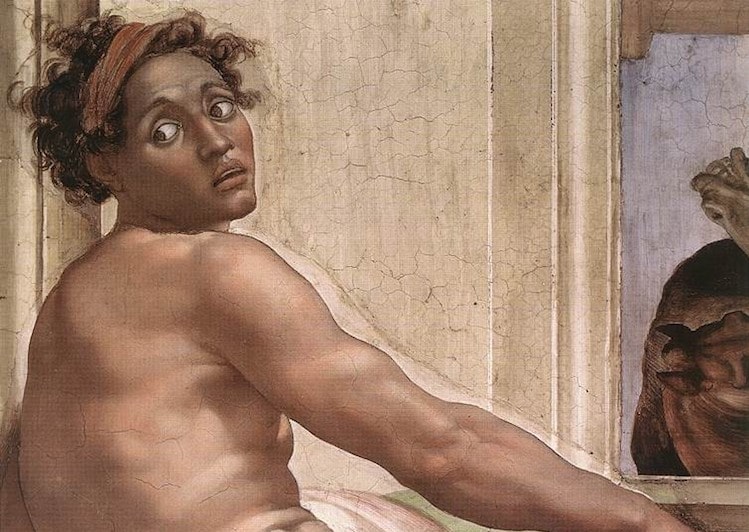
Ignudo from the Sistine Chapel ceiling (Photo: via Wikimedia Commons, Public domain)
In order to reach the chapel's ceiling, Michelangelo created special scaffolding. Rather than build the structure from the floor up, he installed a wooden platform held up by brackets inserted into holes in the wall. As he completed the painting in stages, the scaffolding was designed to move across the chapel.
Once the scaffold was installed, Michelangelo was able to begin the painting process. Like many other Italian Renaissance painters, he used a fresco technique, meaning he applied washes of paint to wet plaster. In order to create an illusion of depth, Michelangelo would scrape off some of the wet medium prior to panting. This method culminated in visible “outlines” around his figures—a detail considered characteristic of the artist.
Since plaster dries quickly, Michelangelo worked in sections, applying planes of fresh plaster each day. These sections are known as giornata, and remain perceptible today.
What Does the Ceiling of the Sistine Chapel Depict?
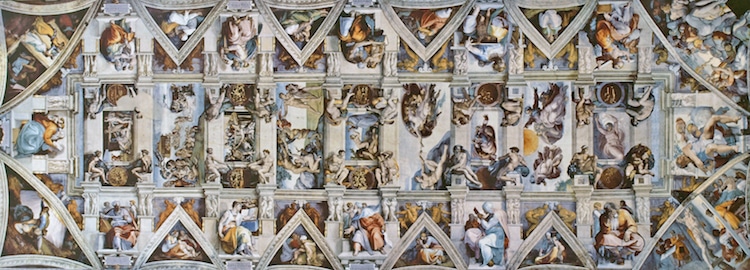
Sistine Chapel ceiling frescoes (Photo: via Wikimedia Commons, CC BY-SA 3.0)
The center of the ceiling is composed of nine scenes from Genesis, the first book of the Old Testament. These panels are surrounded by portraits of important individuals from the Bible. In total, 343 figures are incorporated into the scenes. These include characters from well-known narratives—including the story of Adam and Eve and the Great Flood—as well as Jesus' ancestors, those who predicted his birth, and Ignudi, or nude males.
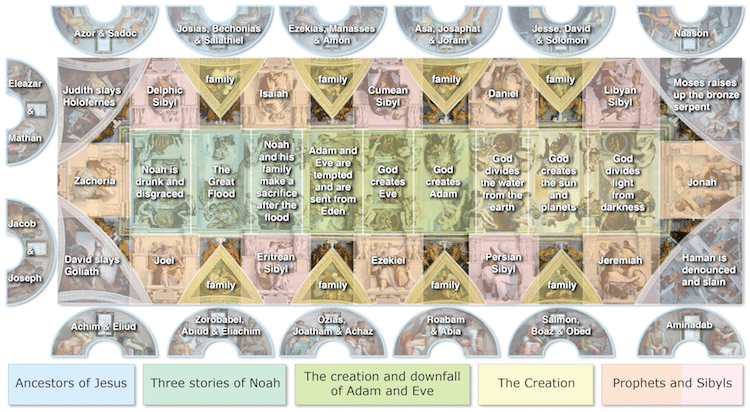
Diagram of the scheme of Michelangelo's frescoes (Photo: via Wikimedia Commons, Sistine Chapel ceiling frescoes (Photo: Wikimedia Commons, CC BY-SA 3.0)
Central Scenes from the Sistine Chapel
The Separation of Light from Darkness
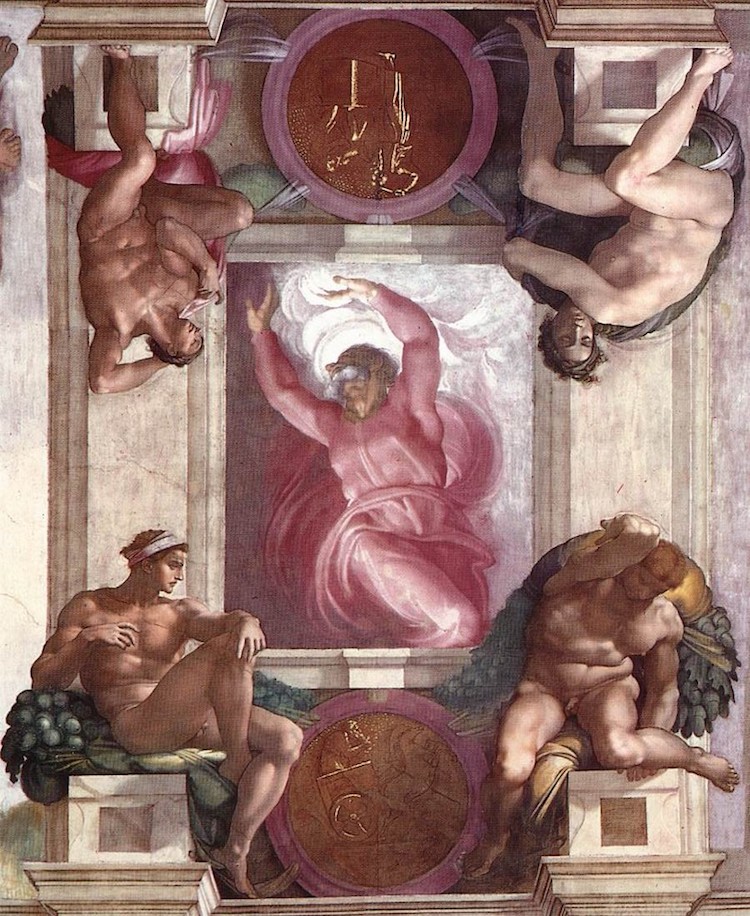
Michelangelo, “The Separation of Light from Darkness,” c. 1508–12 (Photo: Web Gallery of Art via Wikimedia Commons, PD-US)
The Separation of Light from Darkness captures God as He separates light from darkness, creating day and night. It is the first scene from the Genesis chronology, but the last of the nine panels Michelangelo painted.
The Creation of the Sun, Moon, and Vegetation
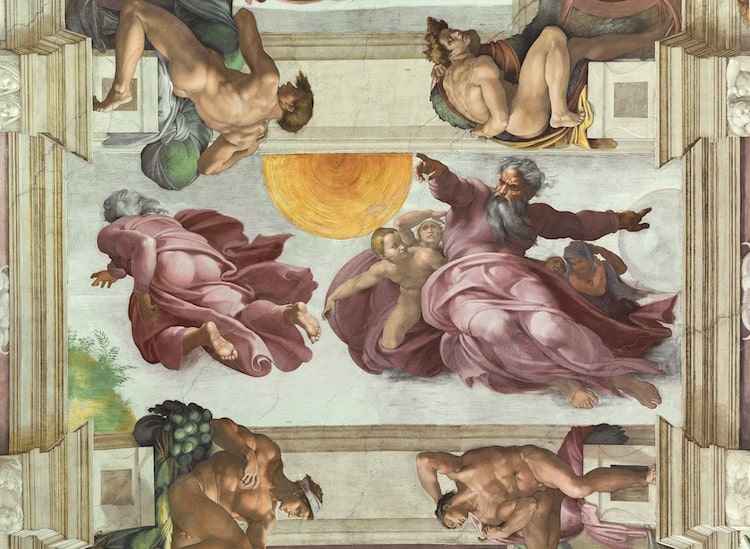
Michelangelo, “The Creation of the Sun, Moon, and Vegetation,” c. 1508–12 (Photo: Sistine Chapel via Wikimedia Commons, PD-US)
In The Creation of the Sun, Moon, and Vegetation, Michelangelo painted a sequential image of God. On the left side is a view of God from behind as he moves towards vegetation; and on the right, God has both arms extended—one pointing towards the Sun and the other gesturing towards the Moon.
The Separation of Land and Water
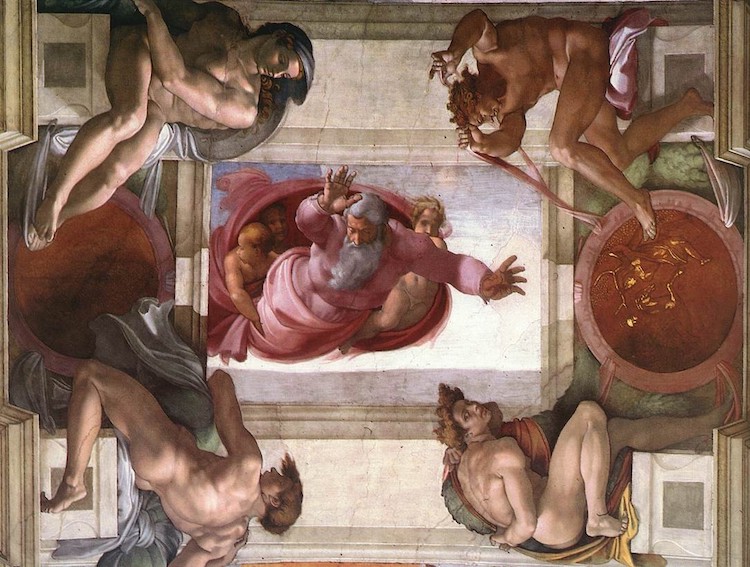
Michelangelo, “The Separation of Land and Water,” c. 1508–12 (Photo: Web Gallery of Art via Wikimedia Commons, PD-US)
In The Separation of Land and Water, God is once again framed by four Ignudi as he performs the action of separating land from water.
The Creation of Adam
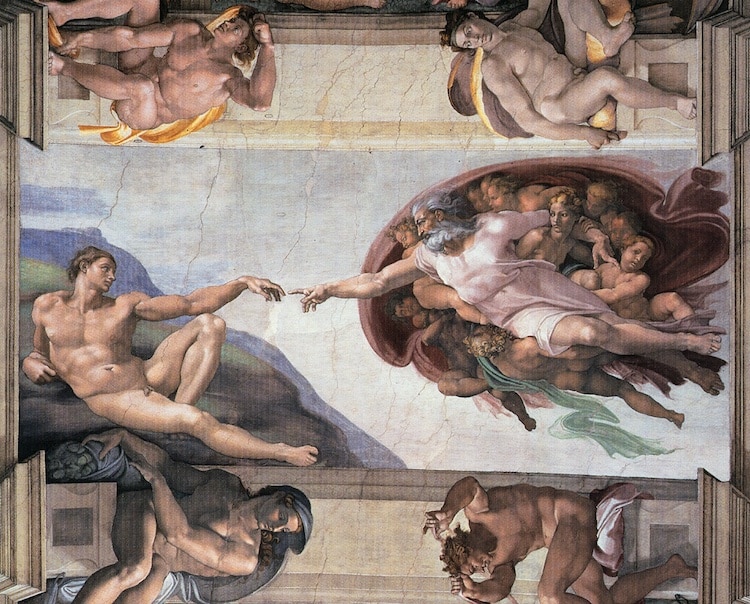
Michelangelo, “The Creation of Adam,” c. 1508–12 (Photo: via Wikimedia Commons, PD-US)
The Creation of Adam is the best-known scene from the Sistine Chapel and one of the most famous Renaissance paintings. It depicts the moment where God—flying through the air and surrounded by angels—bestows life to Adam, who lies recumbent on the ground.
The Creation of Eve
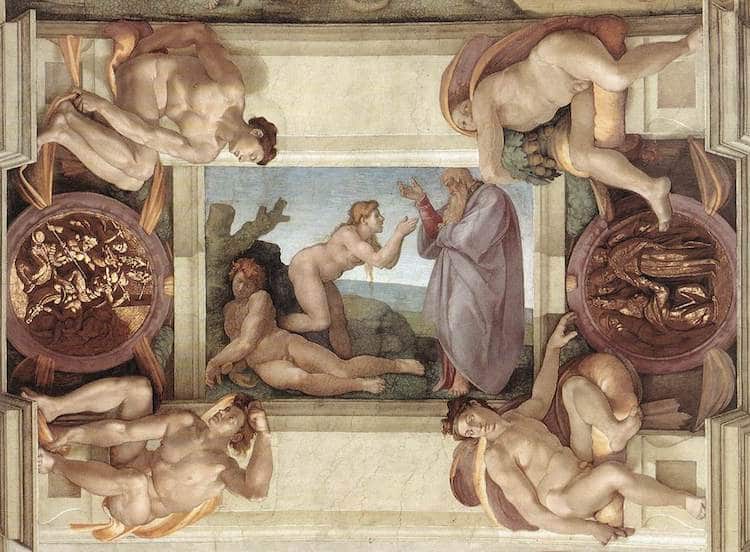
Michelangelo, “The Creation of Eve,” c. 1508–12 (Photo: Web Gallery of Art via Wikimedia Commons, PD-US)
Although not nearly as famous, Michelangelo also painted The Creation of Eve, where God stands over the Biblical female character to grant her life.
The Fall of Man and the Expulsion from the Garden of Eden
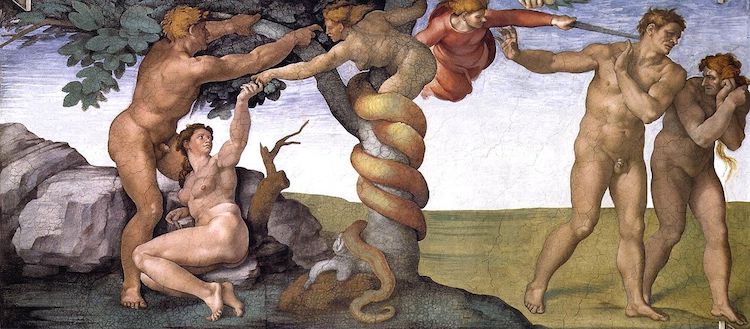
Michelangelo, “The Fall of Man and the Expulsion from the Garden of Eden,” c. 1508–12 (Photo: Web Gallery of Art via Wikimedia Commons, PD-US)
The Fall of Man and the Expulsion from the Garden of Eden places Adam and Eve in the same scene. Another sequential image, on the left side, Adam and Eve have taken a fruit from the forbidden tree from the hand of the Serpent; and on the right, an angel is expelling them from the Garden of Eden.
The Sacrifice of Noah
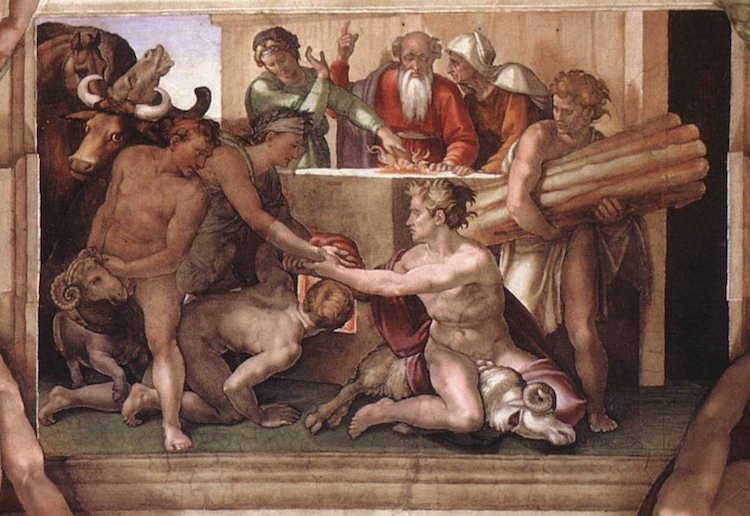
Michelangelo, “The Sacrifice of Noah,” c. 1508–12 (Photo: HumanitiesWeb via Wikimedia Commons, PD-US)
The Sacrifice of Noah is the first of three panels focusing on Noah and portrays the scene where the family of Noah sacrifices a sheep to protect them from the Great Flood.
The Great Flood
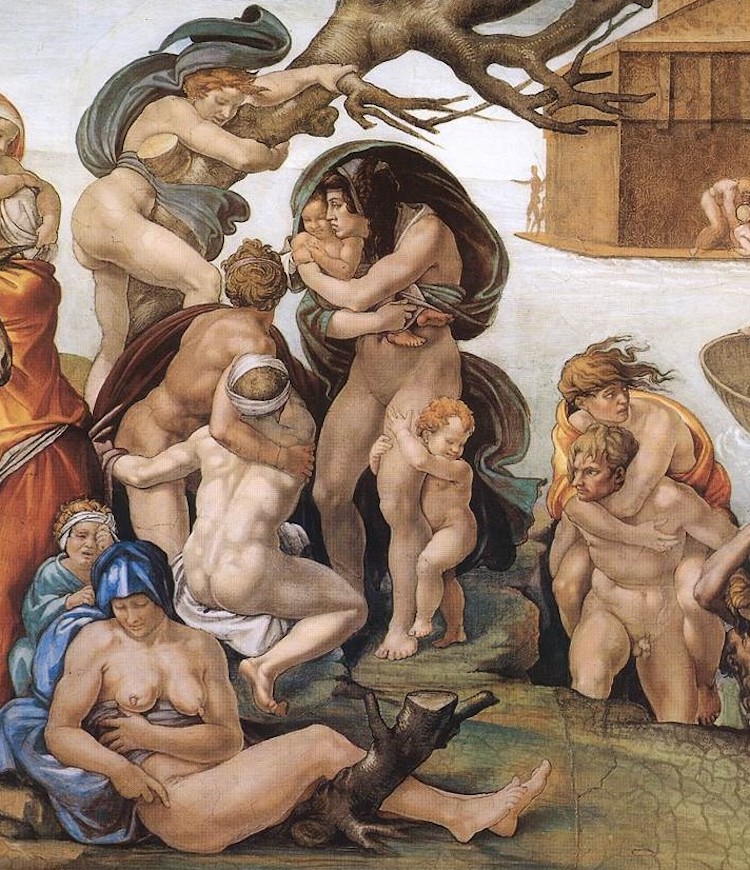
Michelangelo, “The Great Flood,” c. 1508–12 (Photo: Web Gallery of Art via Wikimedia Commons, PD-US)
Next in the Noah series is The Great Flood, which shows a group of numerous figures stranded on land in the foreground and Noah's Ark floating in the background.
The Drunkenness of Noah
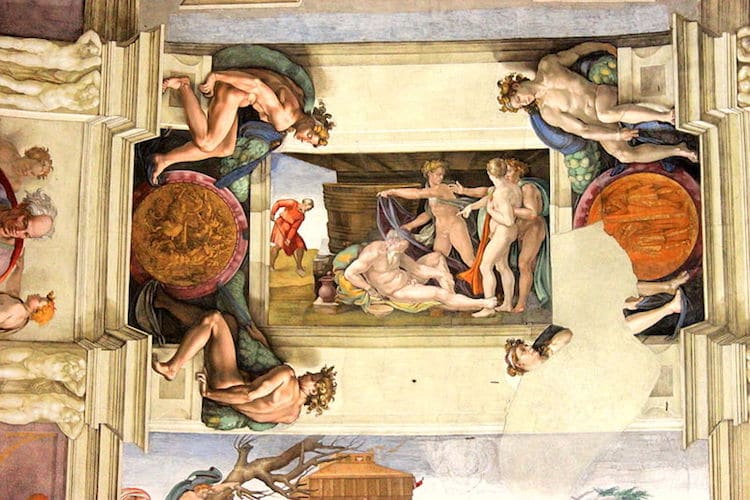
Michelangelo, “The Drunkenness of Noah,” c. 1508–12 (Photo: Jorge Valenzuela A via Wikimedia Commons, CC BY-SA 3.0)
After the Flood, Noah works the land and grows vines. In The Drunknness of Noah, he is depicted in an inebriated state as his youngest son, Ham, calls his brothers Shem and Japheth to see the sight. Afterward, Noah curses Ham.
Examples of Figures
The Prophet Daniel
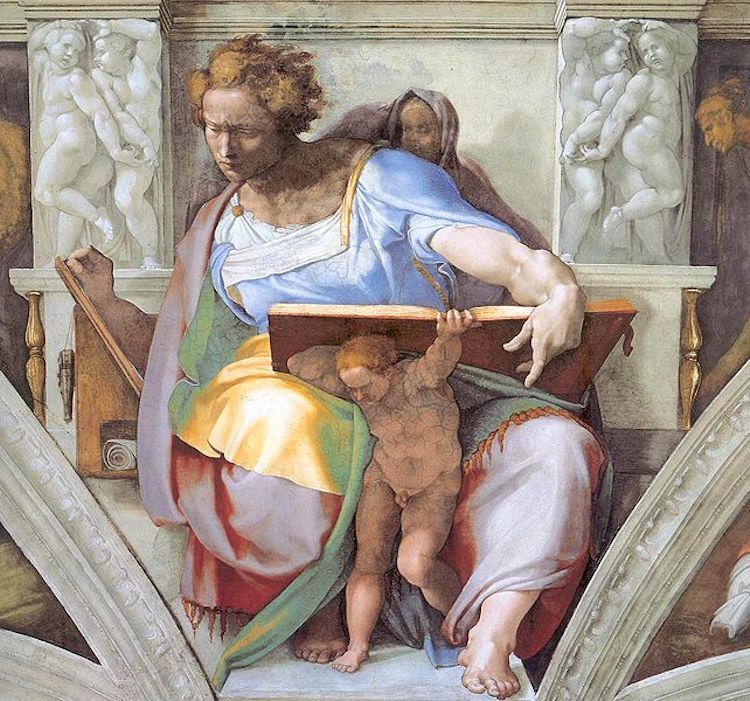
Michelangelo, “The Prophet Daniel,” c. 1508–12 (Photo: Wikimedia Commons, PD-US)
In addition to painting scenes from Genesis, Michelangelo also created portraits of the 12 people who prophesied a Messiah. Among this group are seven prophets from Israel. The portrait of The Prophet Daniel portrays this important figure seated and holding an open book.
The Delphic Sibyl
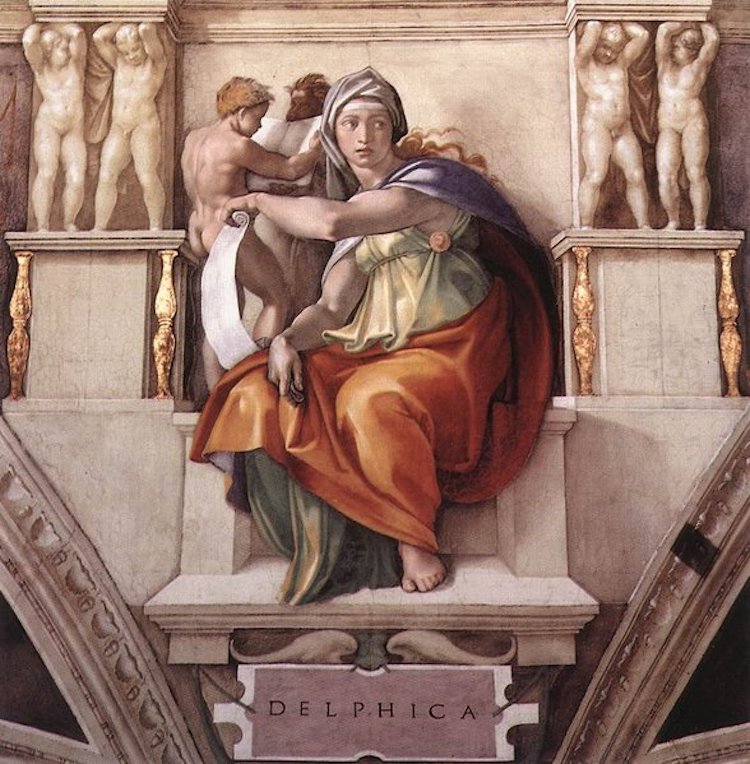
Michelangelo, “The Delphic Sibyl,” c. 1508–12 (Photo: Wikimedia Commons, PD-US)
The other five individuals who prophesied a Messiah were five Sibyls, which were prophetic women who resided in Classical temples. Although not biblical characters, Michelangelo included them because Renaissance artists had an increased interest in Ancient Rome and Greece. The Delphic Sibyl depicts the Sibyl of Ancient Greece in Delphi.
Jesus' Ancestors, Jesse, David, and Solomon
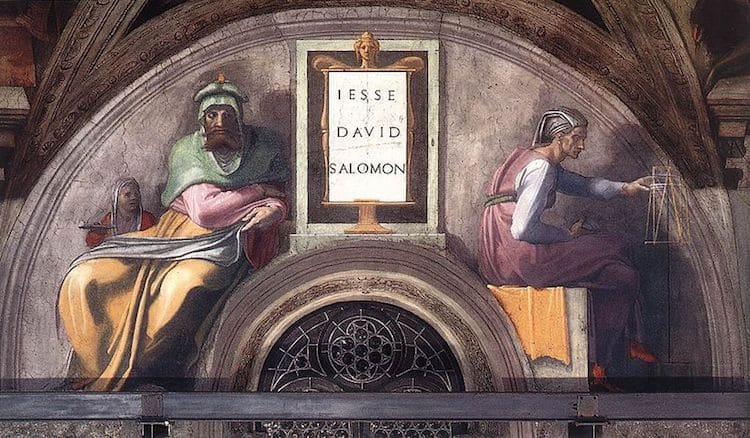
Michelangelo, “Jesus' Ancestors, Jesse, David, and Solomon,” c. 1508–12 (Photo: gallery.euroweb via Wikimedia Commons, PD-US)
Michelangelo chose to decorate the eight lunette windows of the Sistine Chapel with paintings of Jesus' ancestors. Jesus' Ancestors, Jesse, David, and Solomon features three male portraits, two of whom are seated to fit into the limited space.
Ignudo
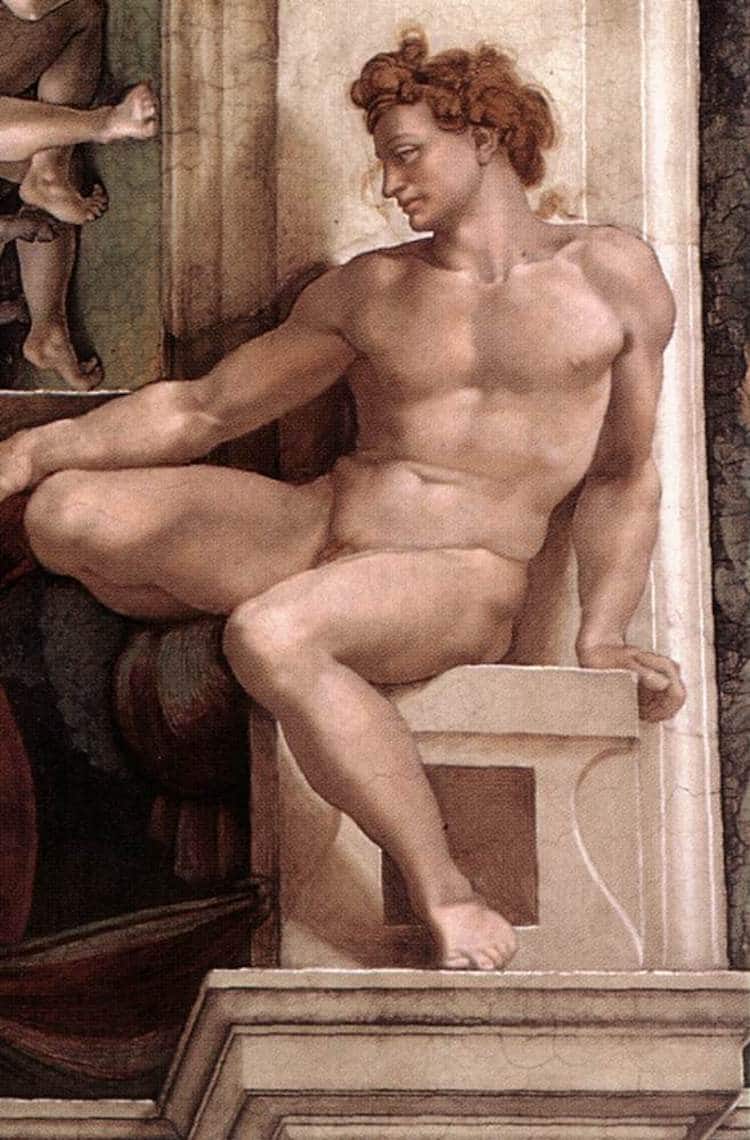
Michelangelo, “Ignudo,” c. 1508–12 (Photo: Web Gallery of Art via Wikimedia Commons, PD-US)
Scattered across the Sistine Chapel ceiling are 20 images of athletic male nudes called ignudi. These figures serve a largely decorative purpose in the different panels.
Legacy
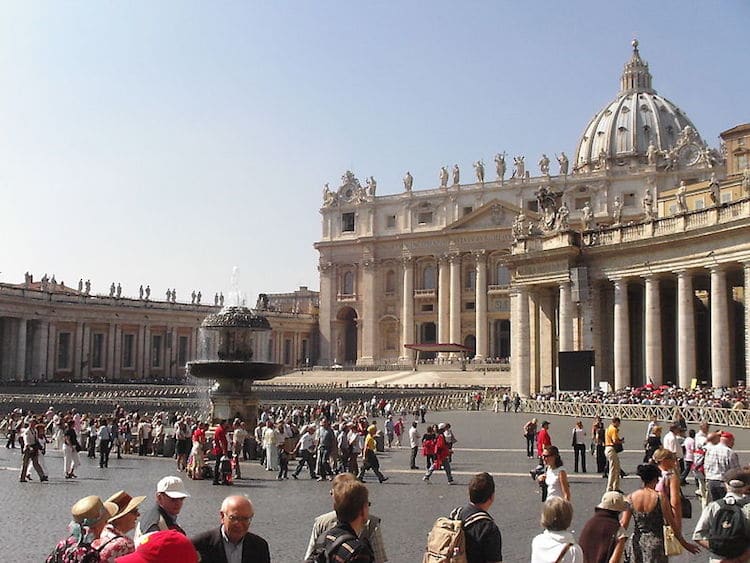
View of Saint Peter's Square, Rome (Photo: Wikimedia Commons, Public domain)
Today, the Sistine Chapel remains both a popular tourist destination and a highly religious site. Roughly 25,000 people view the spectacular ceiling each day, proving the lasting legacy of one of Michelangelo's most well-known works and of the striking art of the High Renaissance.
This article has been edited and updated.
Related Articles:
Rome’s Largest Catacombs with Newly Uncovered Frescoes Will Open to the Public
20+ Art History Accessories That Turn Everyday Objects into Masterpieces
Michelangelo Masterpiece Recreated Using Half a Billion Sprinkles











































































